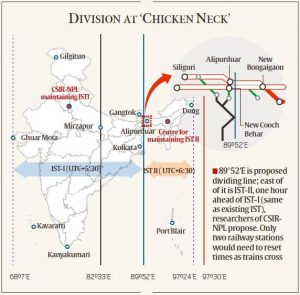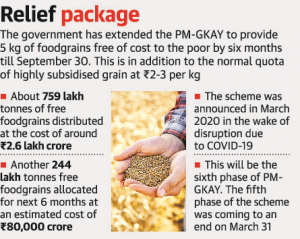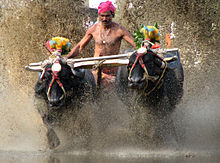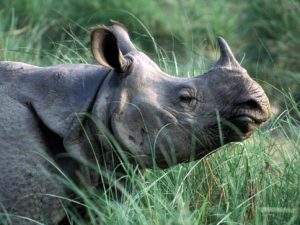THE PHYSICAL AND HUMAN GEOGRAPHY
1. THE DEMAND FOR TWO TIME ZONES IN INDIA
THE CONTEXT: A favorite question of parliamentarians that has repeated, time after time, in every session of Parliament since 2002, is fittingly about time. Cutting across party lines, members from both Houses have for two decades asked the Centre at least 16 times if India proposes to have two time zones and the steps taken to implement it.
THE EXPLANATION:
The India debates,
India extends from 68°7’E to 97°25’E, with the spread of 29° representing almost two hours from the geographic perspective. This has led to the argument that early sunrise in the easternmost parts — the Northeast — causes the loss of many daylight hours by the time offices or educational institutions open, and that early sunset, for its part, leads to higher consumption of electricity.
To deal with this tea gardens of Assam have been following ‘Chaibagaan time’ which is one hour ahead of India Standard Time (IST).
| Do you Know?
3-Time Zones in India: · Interestingly, before independence the country was following three major time zones- Bombay, Calcutta and Madras Time. India had no official time zone till 1906 there were three presidencies: Bombay, Calcutta, Madras, and three local times for the three cities, depending on where they fell on the longitude. · The three time zones, thus created, were followed by all the states or cities around and near it. Calcutta was set at UTC+05.54, making it +00:24 of the current IST. Madras was set at UTC+05:21 making it -00:09of the current IST. Bombay was at UTC+04:51, making it -01:19 of the current IST. Bagan Time was at aroundUTC+06:30, making it +1:00 of the current IST. |
How time is maintained?
If lines of longitude are drawn exactly a degree apart, they will divide the Earth into 360 zones. Because the Earth spins 360° in 24 hours, a longitudinal distance of 15° represents a time separation of 1 hour, and 1° represents 4 minutes. Theoretically, the time zone followed by any place should relate to its longitudinal distance from any other place. Political boundaries, however, mean that time zones are often demarcated by bent lines rather than straight lines of longitude. This is “legal time”, as defined by a country’s law.
The geographic “zero line” runs through Greenwich, London. It identifies GMT, now known as Universal Coordinated Time (UTC), which is maintained by the Bureau of Weights and Measures (BIPM) in France. Indian Standard Time, maintained by CSIR-NPL, is based on a line of longitude that runs through Mirzapur in UP. At 82°33’E, the line is 82.5° east of Greenwich, or 5.5 hours (5 hours 30 minutes) ahead of UCT. While India follows one IST, the United States follows several time zones across its breadth.
New Study:
- Recently, a study done by team of researchers from CSIR-NPL has been published in the journal Current Science that supported the demand of dual time zones for these states and said it is feasible to have dual time zones for them. The study said that technically it is feasible to have two time zones and two ISTs in India.
- It recommended that IST-I for most of India and IST- II for the North-eastern region, this would be separated by difference of one hour. At present, the country observes a single time zone based on the longitude passing through 82°33′E.

THE POLITY AND GOVERNANCE
2. STATES CAN IDENTIFY MINORITIES: CENTRE
THE CONTEXT: In an affidavit filed in the top court, the Union Ministry of Minority Affairs said “state governments can also declare a religious or linguistic community as a ‘minority community’ within the state”.
THE EXPLANATION:
What is the current issue?
The petition by Advocate has contended that the 2011 census showed that Hindus have become a minority in Lakshadweep (2.5%), Mizoram (2.75%), Nagaland (8.75%), Meghalaya (11.53%), J&K (28.44%), Arunachal Pradesh (29%), Manipur (31.39%), and Punjab (38.40%), but were bring denied minority benefits that are currently being enjoyed by the respective majority communities in these places.
Centre’s response:
- The Ministry of Minority Affairs, in an affidavit, said: “It is submitted that the state governments can also declare a religious or linguistic community as a minority community within the said state. For instance, the government of Maharashtra has notified Jews as a minority community within the state of Maharashtra.”
- According to the affidavit,it stated that the Karnataka government has notified Urdu, Telugu, Tamil, Malayalam, Marathi, Tulu, Lamani, Hindi, Konkani, and Gujarati languages as minority languages within the state. “Further, the states too can certify institutions as being minority institutions as per the rules of the said state.
- The ministry clarified that most of these schemes do not involve quotas in jobs and admissions but efforts to raise the education level and participation in employment, skill and entrepreneurship development and reducing deficiencies in civic amenities and infrastructure.
- These are mostly targeted at the most disadvantaged among the minorities such as women and children and those who are economically weaker and hence do not violate the right to equality guaranteed to all under the Constitution.
Where the lacuna lies?
- The constitution mentioned the term ‘minority’ only on two occasions in Article 29 and in Article 30, but it nowhere defines the term, and no effort was made to define it. It was left at the discretion of central government to determine what constitute minorities and they found five religious minorities in India not bothering itself that these minorities are in fact majority in few states.
- The Central government notified six communities, namely Muslims, Christians, Sikhs, Buddhists, Parsis and Jains, as minorities under Section 2(c) of the National Commission for Minorities Act of 1992”.
- The definition provided by United Nations is “Any group or community which is socially, political and economically non-dominant and inferior in population are minorities”.Similarly, Section 2(f) of the National Commission for Minority Educational Institutions Act provides that ‘minority’ means a community notified as such by the Central government.
| Value Addition
National Commission for Minorities (NCM) · National Commission for Minorities (NCM) was set up under the National Commission for Minorities Act, 1992. · It Monitor the working of the safeguards for minorities provided in the Constitution and in laws enacted by Parliament and the state legislatures. · Please note, six religious communities, viz; Muslims, Christians, Sikhs, Buddhists, Zoroastrians (Parsis) and Jains have been notified in Gazette of India as minority communities by the Union Government all over India. Composition: · NCM consists of a Chairperson, a Vice-Chairperson and five members and all of them shall be from amongst the minority communities. · Total of 7 persons to be nominated by the Central Government should be from amongst persons of eminence, ability and integrity. · Each Member holds office for a period of three years from the date of assumption of office. |
THE ENVIRONMENT AND ECOLOGY
3. RHINO CENSUS BEGINS AT KAZIRANGA NATIONAL PARK
THE CONTEXT: The Assam Forest Department began the 14th census of the one-horned rhinoceros at the Kaziranga National Park and Tiger Reserve.
THE EXPLANATION:
- The forests of the Kaziranga National Parkare home to the world’s largest population of Indian one-horned rhinoceroses. The last rhino census was held three years ago in 2018 and since then as many as 400 rhinos died as devastating floods swept Assam, even though the menace of poaching declined significantly.
- Forest officials have identified 76 blocks and invited 60 enumerators and observers for this census.
ABOUT ONE-HORNED RHINOS:
- Only the Great One-Horned Rhino is found in India.
- Also known as the Indian Rhino, it is the largest of the rhino species.
- It is identified by a single black horn and grey-brown hide with skin folds.
- They primarily graze, with a diet consisting almost entirely of grasses as well as leaves, branches of shrubs and trees, fruit, and aquatic plants.
- Conservation status:

- CITES Appendix I
- Wildlife Protection Act, 1972: Schedule I.
Types of Rhinos:
The Greater One-Horned Rhino is one among the five different species of Rhino. The other four are:
- Black Rhino: Smaller of the two African species. (IUCN: Critically Endangered)
- White Rhino: Recently, researchers have created an embryo of the northern white Rhino by using In-vitro Fertilization (IVF) process. (ICUN: Near Threatened)
- Javan Rhino: Critically endangered in IUCN Red List.
- Sumatran Rhino: Recently gone extinct in Malaysia, but Critically Endangered in IUCN Red List.
Kaziranga National Park:
- It was declared as a National Park in 1974.
- It has been declared a tiger reserve since 2007. It has a total tiger reserve area of 1,030 sq km with a core area of 430 sq. km.
- It was declared a UNESCO World Heritage Site in 1985
- It is recognized as an Important Bird Area by BirdLife International.
- The National Highway 37 passes through the parking area.
The park also has more than 250 seasonal water bodies, besides the Diphlu River running through it.
| Value Addition:
INDIAN RHINO VISION 2020 (IRV 2020)
|
THE SECURITY AFFAIRS
4. DRDO’S CORNER-SHOT WEAPON SYSTEM (CSWS)
THE CONTEXT: A corner-shot weapon system (CSWS) designed and developed by the Defence Research and Development Organisation (DRDO) is at an advanced stage of being inducted by the Central Reserve Police Force (CRPF) and the Jammu and Kashmir police.
THE EXPLANATION:
- The CSWS is a special purpose weapon designed by the Armament Research and Development Establishment (ARDE), Pune. It can engage targets located around the corners as the system bends and captures video feed thus saving soldiers from any surprise counter attack and is best suited for urban, close quarter situations.
- The CSWS is equipped with weapon, camera, laser, infrared illuminator and torch in front portion, while display, electronics, battery and swivelling mechanism are located at rear portion, the official said. The body is made from high–grade aluminium alloy to make it lighter and durable.
- Features like day night firing capability, colour display, digital zoom, zeroing facility, hot keys, high power battery along with status display and compliance with JSS 5855 makes it a very potent system for security forces engaged in Counter Insurgency and Counter Terror (CI/CT) operations.
- According to the officials,this indigenously designed and developed system available in 9 mm GLOCK 17/19 and 1A1 Auto Pistol variant.
THE GOVERNMENT SCHEMES AND INITIATIVES IN NEWS
5. THE EXTENSION OF PRADHAN MANTRI GARIB KALYAN ANN YOJANA (PMGKAY)
THE CONTEXT: Union Cabinet has approved the extension of the Pradhan Mantri Garib Kalyan Anna Yojana (PMGKAY) for a period of another six months till September 2022.
THE EXPLANATION:
- In the wake of economic disruptions caused by the unprecedented outbreak of COVID-19 in the country, the Government in March 2020 had announced the distribution of additional free-of-cost food grains (Rice/Wheat) to about 80 Crore National Food Security Act (NFSA) beneficiaries at the scale of 5 Kg per person per month under the PM Garib Kalyan Anna Yojana (PM-GKAY).
- Phase-I and Phase-II of this scheme were operational from April to June 2020 and July to November 2020 respectively. Phase-II of the scheme was operational from May to June 2021. Phase-IV of the scheme is currently operational for July-November 2021 months.
- Pradhan Mantri Garib Kalyan Anna Yojana (PM-GKAY) under the Ministry of Finance is a scheme as part of Atmanirbhar Bharat to supply free food grains to migrants and the poor.
Eligibility
- Families belonging to the Below Poverty Line – Antyodaya Anna Yojana (AAY) and Priority Households (PHH) categories will be eligible for the scheme.
- PHH are to be identified by State Governments/Union Territory Administrations as per criteria evolved by them. AAY families are to be identified by States/UTs as per the criteria prescribed by the Central Government:
- Households headed by widows or terminally ill persons, or disabled persons or persons aged 60 years or more with no assured means of subsistence or societal support.
- All primitive tribal households.
- Landless agriculture labourers, marginal farmers, rural artisans/craftsmen such as potters, tanners, weavers, blacksmiths, carpenters, slum dwellers, and persons earning their livelihood on daily basis in the informal sector like porters, coolies, rickshaw pullers, hand cart pullers, fruit and flower sellers, snake charmers, rag pickers, cobblers, destitute and other similar categories in both rural and urban areas.
- All eligible Below Poverty Line families of HIV positive persons.
THE PRELIMS PERSPECTIVE
6. RAMA LAKSHMANA KAMBALA FESTIVAL
THE CONTEXT: The fifth edition of Rama-Lakshmana Kambala organised by Mangaluru Kambala Samiti will be held at Gold Finch City in Bangrakuloor.
THE EXPLANATION:
About Kambala
- Kambala is the traditional buffalo slush track race Buffalo Race held annually in coastal Karnataka.
- The Kambala season lasts from November to March.
- About 150 kambalas are held in Dakshina Kannada, Udupi and neighbouring Kasaragod (Kerala) districts in the season between November and March. This area is called Tulunadu (Land of Tulu Language).
- A pair of buffaloes is tied to the plough and one person anchors it.
- There are two parallel muddy tracks, on which two competing pairs of buffaloes run. Fastest team wins.
Belief
- According to one belief, Kambala is a festival that originated in the farming community of Karnataka around 800 years back.
- The festival is dedicated to Kadri’s Lord Manjunatha, an incarnation of Lord Shiva.
- It is believed to be celebrated to please the Gods for a good harvest.
- It is a form of recreational sport for the farming community and also another belief is that it is considered as the Sport of the royal (landlord) Family.
THE PRELIMS PRACTICE QUESTIONS
QUESTIONS OF THE DAY 28th MARCH 2022
Q1. If you visit National Chambal Sanctuary, which of the following threatened species you may find?
- Gharial
- Indian skimmer
- Red-crowned roofed turtle
- Gangetic dolphin
Select the correct answer using the code given below:
a) 1 and 2 only
b) 1, 2 and 3 only
c) 1, 3 and 4 only
d) All of them
ANSWER FOR 26TH MARCH 2022
Answer: C
Explanation:
Organization of Islamic Cooperation (OIC)
- It is the second largest intergovernmental organization after the United Nations with a
- membership of 57 states.
- It was established in September 1969.
- Headquarter- Jeddah, Saudi Arabia. (therefore, statement C is incorrect)
- It is the collective voice of the Muslim world.
- India is not member of OIC.


